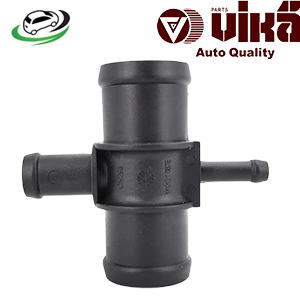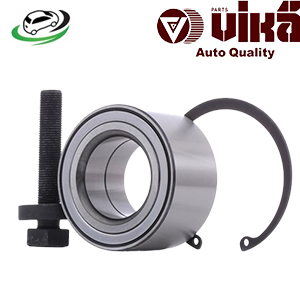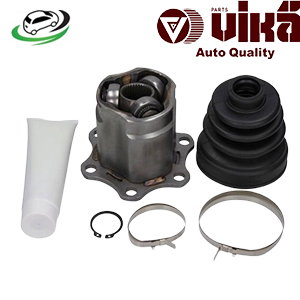-2%
Get AUDI A3 / VW Eos/ Jetta/ Jetta Sportwagen (MK6) Drive Shaft CV Joint Kit 1K0498103E
A drive shaft CV joint kit consists of several components, primarily designed to facilitate the smooth transfer of power from the engine to the wheels. The CV joints allow for a variable angle of operation, accommodating changes in wheel position due to suspension travel, steering input, and road irregularities.
1.1. Components of the CV Joint Kit
Typically, a drive shaft CV joint kit includes:
- CV Joints: These are the heart of the kit, allowing for the flexible movement of the drive shaft while maintaining a constant velocity.
- Boots: These rubber or plastic coverings protect the CV joints from dirt, debris, and moisture, preventing premature wear and damage.
- Grease: High-quality grease is included to lubricate the CV joints, ensuring smooth operation and longevity.
- Clamps: These secure the boots to the drive shaft and the CV joints, preventing grease leakage and contamination.
2. Functionality of CV Joints
2.1. Power Transfer
The primary function of CV joints is to transfer rotational power from the engine through the drive shaft to the wheels. This transfer must occur smoothly and consistently, even as the vehicle navigates bumps, turns, and other dynamic movements.
2.2. Accommodating Angles
Unlike traditional universal joints, which can create a jerky motion at extreme angles, CV joints are designed to maintain a constant speed and smooth operation at various angles. This is essential for maintaining control and comfort while driving.
2.3. Flexibility and Mobility
CV joints provide the flexibility needed for the drive shaft to move as the vehicle’s suspension compresses and extends. This flexibility is particularly important for front-wheel-drive vehicles, where the drive shafts must accommodate steering angles.
3. Types of CV Joints
There are several types of CV joints, each with its design and applications:
3.1. Ball-Type CV Joints
- Design: These joints use multiple balls contained within a spherical race. They are commonly used in front-wheel-drive vehicles.
- Advantages: Provide smooth operation and accommodate larger angles, making them ideal for vehicles with significant steering movement.
3.2. Tripod-Type CV Joints
- Design: This type features three prongs that ride within a socket. They are often used on the inboard side of the drive shaft.
- Advantages: Allow for smoother operation at high angles and provide greater flexibility, particularly in the suspension.
3.3. Double Offset CV Joints
- Design: These joints consist of two CV joints connected in series, allowing for greater articulation and flexibility.
- Advantages: Ideal for vehicles with complex suspension systems, such as off-road vehicles.
3.4. Fixed and Floating Joints
- Fixed Joints: These maintain a constant distance between the two connected components.
- Floating Joints: These allow for some axial movement, accommodating changes in length due to suspension travel.
4. Benefits of Using a CV Joint Kit
The drive shaft CV joint kit offers numerous advantages for vehicle performance and longevity:
4.1. Smooth Operation
CV joints provide seamless power transfer, resulting in a smoother ride and improved handling. This is particularly important in vehicles that frequently navigate tight turns or uneven terrain.
4.2. Enhanced Durability
Quality CV joint kits are designed to withstand high stress and extreme conditions, contributing to the overall durability of the drivetrain.
4.3. Improved Fuel Efficiency
Efficient power transfer reduces energy loss, which can lead to improved fuel economy. This is especially beneficial in modern vehicles designed for maximum efficiency.
4.4. Reduced Noise and Vibration
Well-maintained CV joints minimize noise and vibration, leading to a quieter and more comfortable driving experience.
4.5. Extended Component Life
Regular maintenance of the CV joint kit, including lubrication and boot inspection, can extend the life of both the CV joints and the drive shaft, reducing the need for costly repairs.
5. Common Issues with CV Joint Kits
Despite their durability, CV joints can experience problems that affect vehicle performance:
5.1. Boot Damage
The rubber or plastic boots that cover the CV joints can become cracked or torn due to exposure to heat, debris, or age. Damaged boots allow dirt and moisture to enter the joint, leading to accelerated wear.
5.2. Grease Leakage
If the clamps securing the boots fail or the boots become damaged, grease may leak out. Insufficient lubrication can result in increased friction and wear, ultimately leading to joint failure.
5.3. Joint Wear and Failure
Over time, CV joints can wear out due to constant movement and load. Signs of wear may include clicking or popping noises during turns, vibrations while driving, or the feeling of looseness in the drivetrain.
5.4. Corrosion
Inadequate protection from moisture and contaminants can lead to rust and corrosion within the joint. This can compromise the joint’s functionality and lead to premature failure.
6. Signs of a Failing CV Joint Kit
Recognizing the symptoms of a failing CV joint kit is essential for timely intervention and repair:
6.1. Clicking Noises
One of the most common signs of a failing CV joint is a clicking or popping noise when turning the vehicle. This indicates that the joint is worn and may need replacement.
6.2. Vibrations
If you experience unusual vibrations, particularly during acceleration, it could be a sign of a worn or damaged CV joint.
6.3. Grease on the Wheel or Suspension Components
Visible grease on the inside of the wheel or suspension components may indicate a torn boot or leaking grease from the joint.
6.4. Loose or Unresponsive Steering
If the steering feels loose or unresponsive, it could be a sign of worn CV joints or related components. This can affect vehicle handling and safety.
6.5. Unusual Movements
If you notice that the drive shaft is moving excessively or appears misaligned, it could indicate issues with the CV joint or its mounting.
7. Maintenance of Drive Shaft CV Joint Kits
Proper maintenance of the drive shaft CV joint kit is essential for ensuring longevity and performance:
7.1. Regular Inspections
Conduct regular inspections of the CV joints and boots. Look for signs of wear, such as cracks, tears, or grease leakage.
7.2. Boot Replacement
If a boot is damaged, it’s crucial to replace it immediately to prevent contamination of the joint. Boot replacement is often less expensive than full joint replacement.
7.3. Grease Checks
Periodically check the grease levels within the CV joint. Some kits come with grease fittings that allow for re-lubrication.
7.4. Keep the Area Clean
Regularly clean the areas around the CV joints and drive shafts to prevent dirt and debris from entering the joints.
7.5. Professional Inspections
Consider having the drive shaft and CV joint inspected by a professional during regular maintenance services. They can identify potential issues early and recommend necessary repairs.
8. Conclusion
The drive shaft CV joint kit is a vital component of a vehicle’s drivetrain, enabling smooth and efficient power transfer while accommodating the dynamic movements of the suspension. Understanding the functionality, types, benefits, and common issues associated with CV joints is essential for vehicle owners. Regular maintenance, including inspections and timely replacements, can prevent significant problems and ensure optimal performance and safety. By prioritizing the health of the CV joint kit, drivers can enjoy a smoother ride, improved vehicle handling, and enhanced longevity of their vehicle’s drivetrain.
Follow us on Facebook for more parts.




Reviews
Clear filtersThere are no reviews yet.